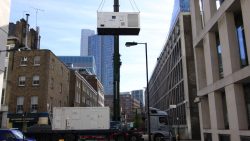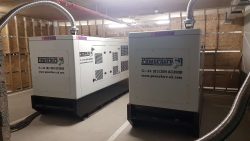Client: The client is a well-established global work place Facilities Management Solutions Company with roots tracing back to California from 1906. Growing to one of the largest commercial real estate service companies in the western US and achieving significant global expansion in 1998 with the acquisition of the international arm of a London based company.
Site: Established in 1881, the museum, where the switchgear is positioned, has become one of London’s top visitor attractions with more than 4.5 million people from the UK and across the world visiting in 2018, with an incredible 100 million people since it opened in 1881. It houses a collection of 80 million specimens and is the world’s greatest repository of information about this planet.
Collectively, along with all London’s museums and galleries, the museum helps to generate at least £1.5 billion a year for the British economy* (*according to a study by the London School of Economics).
Project Brief:
Three of London’s museums based in South West London share a common High Voltage (HV) Main Intake Sub Station located on the ground floor of one of the museums. Works were scheduled to replace the 40 year old switchgear which will involve the removal of the existing switchgear to facilitate the installation of the new equipment.
To mitigate the risk of a power failure whilst replacement works were being carried out, there was a requirement to have sufficient temporary generator power to support the museums to ensure that they were kept open to the public during the course of the works.
The initial invitation to tender was distributed five months prior to the planned replacement works via our sister company, The Generator Company who having worked with the client for many years and being a preferred supplier has built up a mutually respected relationship over this time.
The invitation to tender was passed to our Powerhire Sales Director to follow up and communicate directly with the client to obtain further information. Once introductions had been made with the clients’ Project Manager our Powerhire Sales Director attended site to meet with the Project Manager and carry out a site survey to assess the site conditions, site constraints and existing services.
We were asked to deliver a solution to provide 3MVA of power at 6.6kV to support the three museums during the replacement switchgear works. Following the site survey and subsequent meetings with our Projects Director we submitted our proposal to supply 12 off 500kVA sync standby generators, along with 6 x 3000L bulk fuel tanks and 2 x 4MVA transformers to be sited in the courtyard at the request of the client.
Following a successful tender bid, the first of many planning meetings was attended by our Powerhire Sales Director, the client’s Project Manager, Project Director from the principle contractors, the principle designer and the project board representing all three museums to discuss the requirements of the project, location of the equipment and expected programme of works.
It was requested by the client that the temporary power be located in the courtyard of the museum but later in the design stage it was determined that owing to loss of car parking spaces and the proximity of the generators to the switchroom the equipment would be located on the grassed areas either side of the accessible road leading to the courtyard and adjacent to the building where the switchgear is situated.
Following ground condition and measurement checks to ensure it would be suitable for locating the equipment, it was essential that consideration was given to the design layout of the equipment ensuring that an emergency walkway be created from the building through the compound and out into the access road. It also meant that due to the equipment now being sited on public ground, all works would have to be completed out of normal working hours to ensure that disruption was kept to a minimum and emergency exits were not compromised during opening hours.
Once planning approval had been received and a programme of works submitted by the principle contractor we were able to move forward with the design and preparation for delivering and installing 12 x 500kVA sync standby generators, 6 x 3000L bunded fuel tanks, 2 x 4 MVA transformers and 2 x lighting towers. The equipment will be split into 2 groups situated on the grassed area either side of the access road into the museum. This procedure will allow all 12 sets to be run up correctly and sync together to power up the transformer in the event of a power outage.
With the design approved and the submission of method statements, risks assessments and operational procedures the works were booked in and scheduled to commence on the evening of the first day at 6pm.
On the agreed day of installation, the 130 tonne crane and ballast arrived on site at 6pm as scheduled, to set up and await delivery of all temporary equipment. The 9 artic lorries used to transport all equipment to the site in London from our depot in Dover start to arrive from 7pm at half an hour intervals and await instructions from the on-site traffic marshals.
The lorries were guided into their designated position on the access road in succession and equipment craned off into place within compound 1 and 2. This continued throughout the night until all 9 lorries were unloaded.
The following day, the scaffolders arrive to construct bridged scaffold over the arched access into the courtyard along with two towers installed at 2.4m high to allow cables to pass over emergency exit paths from the building through the compounds. On completion, our cable technicians could then start to run out the 975 meters of cable routing over the scaffold towers keeping access and fire exits clear.
Our Commissioning Engineer attended site the following day to connect generators 1-6 to the first transformer LV connection point via the Mains Distribution Board (MDU) and generators 7-12 to the second transformer LV connection point via the MDU. All 12 sets were checked for oil levels, fuel levels and coolant levels, each set started individually and run on its bulk fuel tank. Enough fuel was to be left on site to run the generators for a minimum of 12 hours if needed with fuel tanks on standby if needed.
With the generators on standby only to run in the event of a power failure, they were left turned off with batteries isolated and switched to bulk fuel tanks. All cables were left coiled ready to be run out in the event of a power outage. In the event of a power outage, operational procedures would be adhered to by our Powerhire engineers who, as always, are available 24 hours a day 7 days a week during the course of the switchgear upgrade.
Following the successful upgrade of the switchgear, fortunately with no power outages or disruption to the running of the museums throughout, the disconnection and collection of all equipment was carried out on the agreed date, again out of working hours, to minimise disruption.
It was a pleasure working alongside the project team throughout this project. Their brief was uncomplicated, they knew what was needed and the project went according to plan with no delays or interruptions. We look forward to working with the client again in the future. Kerry Moggridge, Powerhire Sales Director




